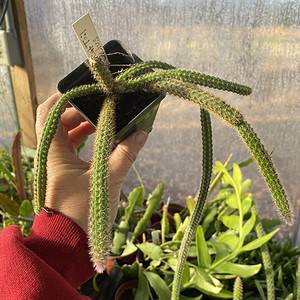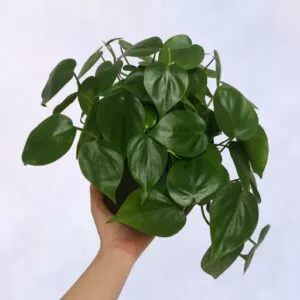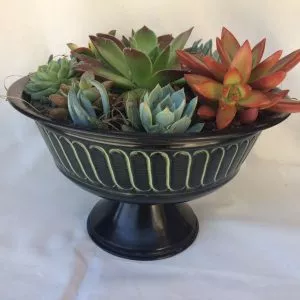No products in the cart.
Weeping cherry trees are renowned for their graceful, cascading branches and stunning spring blossoms. These ornamental trees can be a beautiful addition to any garden, and growing them successfully requires some knowledge and care.
This comprehensive guide will explore everything you need about weeping cherry tree cultivation, from the basics to more advanced topics. We’ll also delve into common diseases and pests that can affect these trees and provide answers to frequently asked questions.
What is a Weeping Cherry Tree
Weeping cherry trees are Prunus trees with a prominent weepy habit, with arching branches that give the tree a flowing, fountain-like shape.
There are several popular varieties of these trees, including:
Weeping Higan cherry (Prunus subhirtella): One of the most classic trees, with pale pink flowers in early spring. Grows 15-25 ft tall.
Pendula weeping cherry (Prunus pendula): Fast-growing large tree up to 30 ft tall. Has light pink blooms.
Kanzan weeping cherry (Prunus ‘Kanzan’): Violet-pink double blooms. Grows around 15-25 ft.
These trees are graceful ornamental plants, not fruiting trees. They add visual interest and beauty to landscapes with the tree canopy. The cascading branches provide unique seasonal interest with abundant spring blooms, vibrant fall leaf color, and attractive branching structures.
The flowers blossom for a few weeks in spring and are followed by weeping branches with green leaves that turn yellow in fall and start to drop in winter. Still, the tree does not grow those delicious 😋 sweet cherries everyone enjoys.
But you can find the Prunus avium known as Bing cherries 🍒 if you want something sweeter in your garden. The tree does grow black berries that birds love.
Growing Weeping Cherry Trees

When it comes to how to grow weeping cherry tree and where to plant weeping cherries, we recommend choosing a spot with plenty of room to grow. The tree has a spreading habit and grows well on the lawn or a border.
Another thing to consider is to shelter it from strong winds, which can damage those gorgeous blossoms. While in low areas, the hard frost can also scorch the flowers. Finally, you can plant bare-rooted trees from fall to winter while dormant.
You can plant container-grown trees at any time of the year. However, the planting hole you dig for your young trees must be wider than the root ball, allowing the roots to spread. Also, keep the root ball at the soil level, firm it down, and give it water with some mulch over the soil.
The mulch you use can be compost or chipped bark, as it helps with moisture retention. Also, use tree spikes to stake your young trees to keep them secure. Also, allow for a spot where your weeping cherries can grow well, reaching up to 25 feet tall and wide.
Weeping Cherry Tree Care
Proper care is vital for the health and vitality of weeping cherry trees. This section will discuss the key aspects of care for these elegant trees. Still, even if people say this tree is a low-maintenance indoor plant, it is not when it is still young. But people say that this tree will flourish in your garden with some time, training, and patience.
Soil

The weeping cherry only needs a garden loam and well-drained soil with good air circulation. You can amend the soil to prevent root rot, allowing it to drain well. So, if needed, provide adequate drainage by adding perlite to the mix.
When backfilling the hole, firmly press it around the trunk to remove the air pockets.
Weeping Cherries Light Needs

Your weeping cherry tree needs at least six hours of full sun to display single to double flowers. When choosing a spot to place your tree in the ground, choose one with direct sunlight to light shade. With too much shade, it will result in inhibited spring blooms and too much direct sunlight can result in burnt leaves.
Watering Prunus Pendula
The weeping cherry tree does not do well in dry or soggy soil. So, if you find dry spells during the year, ensure to provide your tree with water throughout the growing season. For the weeping cherry to thrive, it needs at least 80 gallons of weekly water.
During warm weather, you can water your trees at least twice a week. But still, let the soil dry between watering to prevent root rot. The tree fails to bloom those beautiful pink flowers when not provided enough water.
Good drainage is also essential, allowing excess water to drain from the roots. You can leave the roots during winter to rest and not water your tree.
Temperature & Humidity

The weeping cherry tree is heat and drought-tolerant to some extent and grows in most of the US, where you find average temperatures above 20°F. So, you can plant them in the USDA hardiness zones four and higher.
The tree is also pretty cold hardy, but if the temperatures drop below freezing point, we recommend you add mulch to the root section and, if needed, wrap some burlap around the trunk.
Fertilizing Flowering Trees
You can feed your weeping cherry tree in spring to encourage growth. You can provide your trees three months after planting to help them recover from transplant shock but not during planting, as it can burn the roots.
Once the roots are established, it helps to use an acidic fertilizer. A slow-release fertilizer is recommended. Spread the granules on the surrounding soil away from the trunk. You can increase your fertilization as soon as buds form on the branches.
Pruning Weeping Cherry Tree
To keep your tree looking great, it helps to do regular pruning during spring and summer. When you prune the tree, it helps to keep it under control and give it a uniform shape. It also helps young leaves to sprout.
You can remove diseased branches, water spouts starting to show at the base, and new branches looking as if they are upright and not growing straight. Also, prune any main branches before they touch the ground, as it will invite pests and diseases.
Lastly, you can remove the branches that start touching each other, allowing good air circulation to move through the leaves. Removing the suckers growing at the tree’s base is essential, as they will take over your cherry tree.
We recommend removing it from grafted trees at the scar at the top of the rootstock below the branches. Also, remove the shoots growing out of the graft scar. If you notice disease-affected branches, remove them immediately.
Propagating Your Weeping Cherry Tree
As your weeping cherry tree is most likely grafted, taking a cutting will not produce another similar tree. The same applies to planting the seed, which is not true for the parent.
Weeping Cherry Varieties
Okay, before we get to the varieties, you will find people marketing a dwarf weeping cherry tree. No such variety is available, and the only time it will remain in a dwarf form is with regular pruning.
Kiku-shidare-zakura

The weeping branches form clusters of pink double-petal flowers in spring.
Pendula Rubra
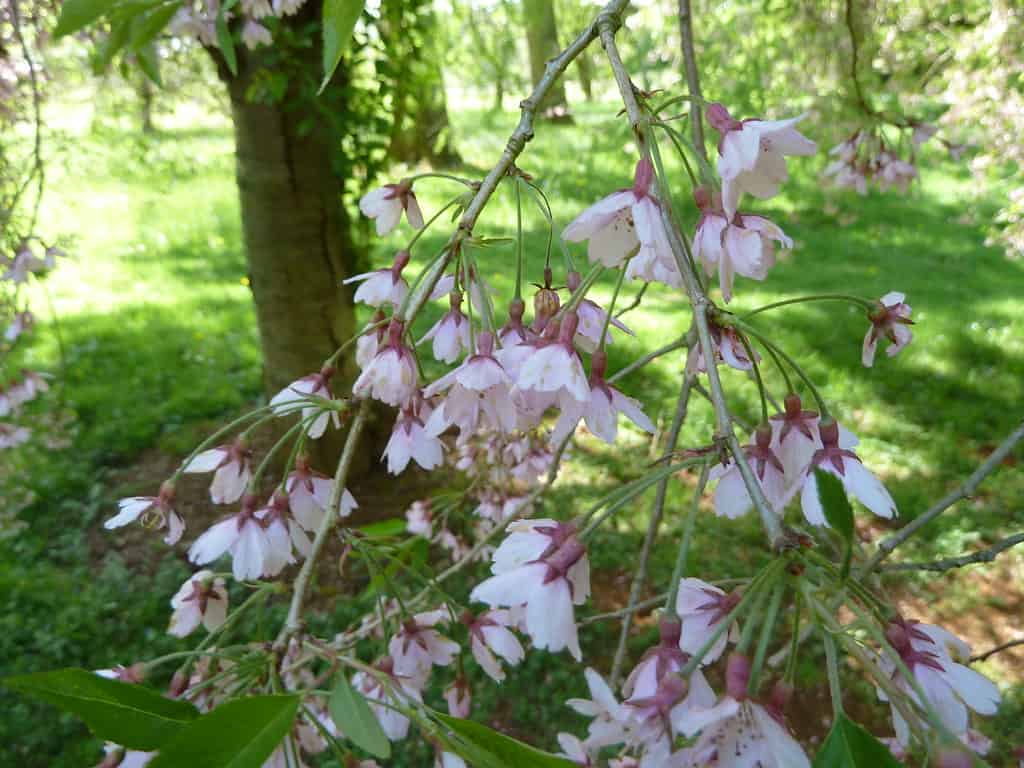
It blooms single bright pink flowers in spring with a gorgeous leaf color in fall.
Shidare-Yoshino
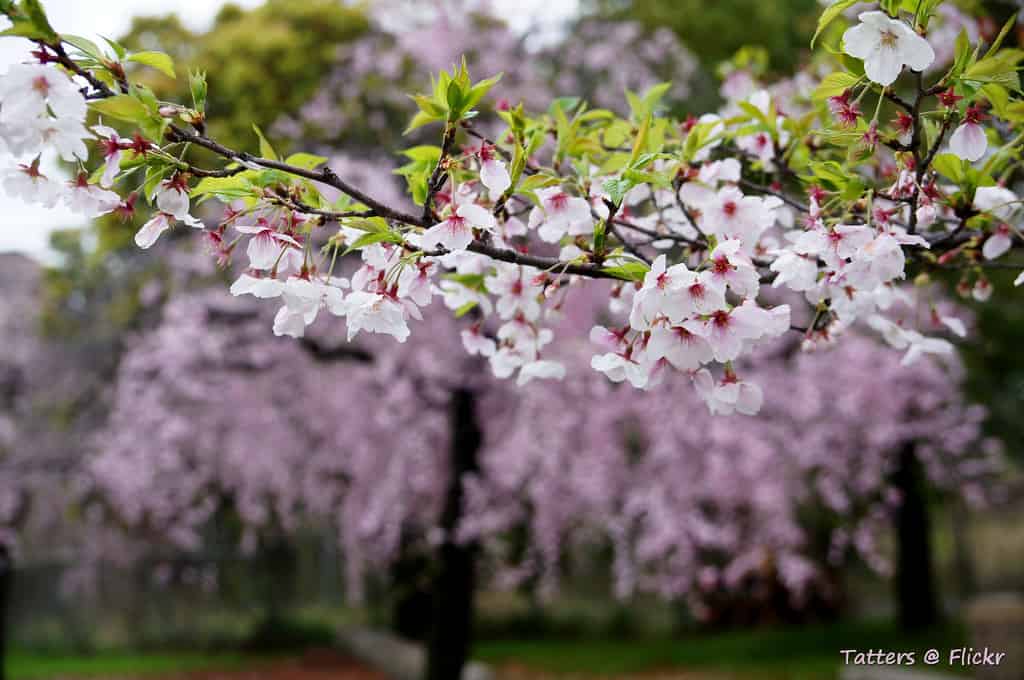
The tree develops weeping branches with masses of small single white to blush pink or white flowers.
Snow Showers
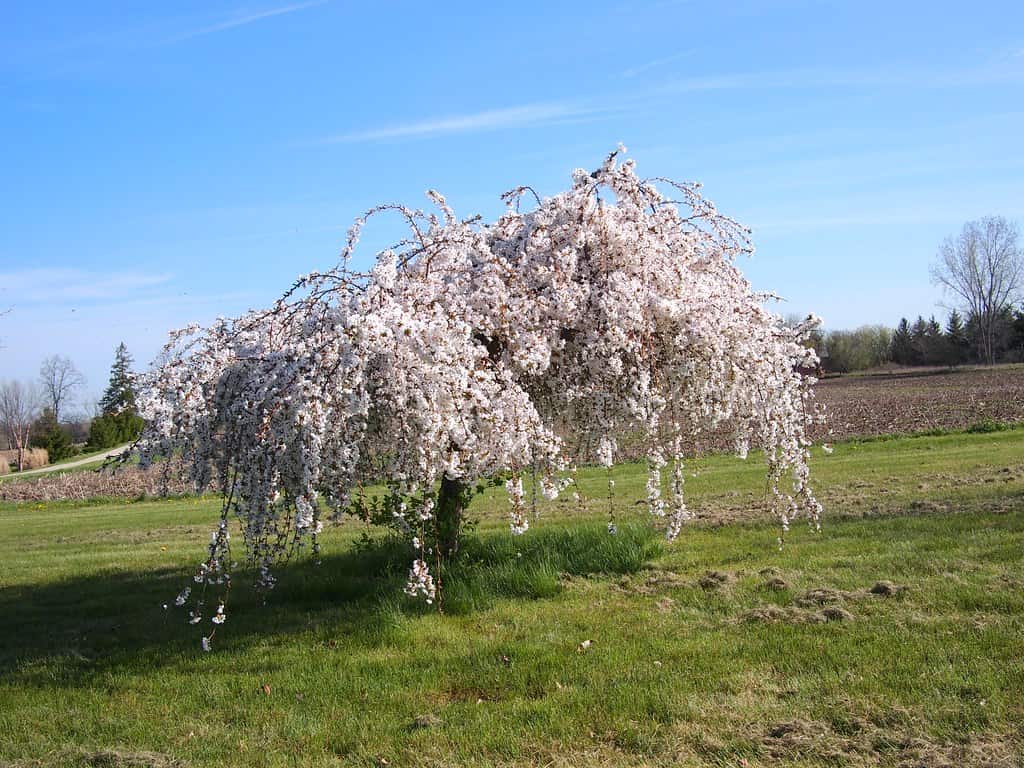
As with most of these cherry trees, they bloom single blossoms but are in pure white.
Weeping Cherry Common Diseases & Pests

Your weeping cherry tree is not pest-resistant or disease-free and can become the home of the following:
Aphids feed on the plant sap in large colonies, and you can find several types. But the most common one is the black cherry aphid with a shiny black color. You will notice wilted leaves begin starting, and it has a sticky residue.
Cherry leaf spot is a fungal infection that causes yellow, purple, and black spots, with the size expanding from the spread of the disease. The leaves will start falling off prematurely.
Cytospora cankers is another fungal infection that leaves yellow to gummy lesions on the bark. The trunk starts to die, and the leaves fall off.
Japanese beetles have shiny green bodies with tan wings and feed on the foliage in groups.
Powdery mildew will appear on the leaves as a white powder, leading to stunted growth.
Other insects are spider mites and tent caterpillars that can cause havoc in your trees.
Lastly, you have twig cankers, a bacterial disease that leaves discolored twigs with a rough texture and is found mostly in your younger trees. Another concern is verticillium, a fungal infection causing yellowing leaves that wilt with branches dying and stunted growth.
Frequently Asked Questions
Once established, weeping cherries grow at a moderate rate of 1-2 feet per year. Depending on the exact variety, they typically reach around 15-30 ft. tall at maturity. Proper pruning in youth supports healthy shape development.
No, they are purely ornamental cherries, not a fruiting tree. The weeping cherry flowers are showy but do not develop into edible cherry fruits. For fruit, opt for a sour cherry, sweet cherry, or other fruiting cherry tree instead.
Yes, weeping cherries are deciduous, meaning they lose their leaves in late fall before going dormant for winter. The leaves turn vivid shades of orange, red, and yellow in autumn. In spring, fresh new leaves emerge alongside the blooms.
Apply a balanced, slow-release fertilizer or compost around your weeping cherry tree in early spring each year. This provides nutrition for growth and flowering. Avoid over-fertilizing, which can cause excess foliage growth at the expense of blooms.
The variety ‘Snow Fountains’ is a great compact weeping cherry tree for smaller spaces, growing to around 8-15 ft. tall at maturity. It has a rounded form with white blooms. These are beautiful trees.
Signs of overwatering include yellowing or wilting leaves, sparse foliage, stunted growth, bark damage near the base, and significant dieback. Allow the soil to dry out between waterings to prevent issues partially.
Growing a graceful weeping cherry tree can create a stunning focal point and provide blossom-filled spring beauty in the landscape. Follow the key care guidelines to support your tree for many years of enjoyment. With the proper site conditions and pruning, they will thrive.
Whether you want to buy, sell, or simply reach out to other plant enthusiasts, Plantly is the right place to be!
-
$15.00Sold By: BubbleBlooms
In stock
Ficus lyrata Bambino, 4 inch, Dwarf Fiddle Leaf Fig Tree
Rated 4.81 out of 5 based on 279 customer ratings00Sold By: BubbleBlooms -
$16.00Sold By: Smoot's Farm
In stock
Cactus Golden Rat Tail or Aporocactus Flagelliforms 2.5 Inch Pot
Rated 4.89 out of 5 based on 27 customer ratings00Sold By: Smoot's Farm -
$15.00Sold By: Gardengineering
$20.00In stock
Philodendron Cordatum Heartleaf | Emerald Philodendron
Rated 4.96 out of 5 based on 25 customer ratings00Sold By: Gardengineering -
$60.99Sold By: Succulent Oasis
In stock
Large Succulent Arrangement in a Black with Green Tin Pedestal Planter.
Rated 4.84 out of 5 based on 352 customer ratings00Sold By: Succulent Oasis

